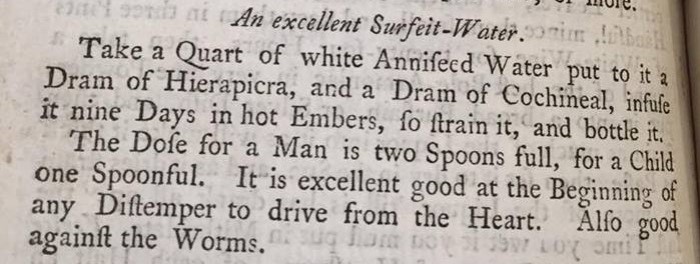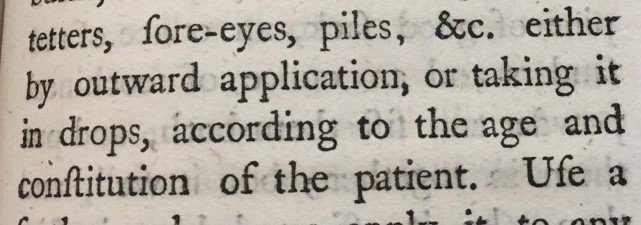Both Anne Battam and Sarah Jackson have demonstrated the encouragement of experimentation by including receipts with little or no efficacy statements. As part of printed books, these receipts were likely to be marketed at a public audience. It would be interesting to use manuscripts such as A book of culinary and medicinal recipes in various hands (1767-69) to trace a trend, particularly with manuscripts being predominantly used for personal benefit. Despite this difference between printed and manuscript books, both types of literature face the same problem of challenges to authorship and ownership. The books are compiled from receipts circulated between gentlewomen and homosocial groups, challenging historian Monica Green’s argument that receipt books were the first genre of women’s medical knowledge (1). We could support these claims though, by focusing on experimentation as part of the receipt.
‘Mary Leigh’, the supposed owner / compiler of the manuscript, might have shown her female medical expertise by encouraging the reader to participate in experimentation. If we were to find corresponding receipts with no statement of success, then experimentation is encouraged as part of the receipt because the reader needs to discover the outcome. Efficacy (or success) statements were a continuation from the seventeenth-century, so to find them absent in the manuscript from 1767 would suggest that the reader is in charge of obtaining results.
The manuscript contains two corresponding receipts called A receipt for the bite of a mad dog and Dr Mead’s receipt for the bite of a Mad Dog. Both receipts require a somewhat similar level of knowledge on the anatomical differences of men and women by referring to different dosage administrations. However, the first receipt requires the purchasing of Venice treacle, a significantly costly and complex ingredient (Ingredients and Self-Treatment). At this stage, this appears to be the only obstruction which might cause a reader to consider only experimenting with one receipt. In our previous post (Encouraging Experimentation: Anne Battam), we discussed the hindrances caused to experimentation by expensive ingredients. However, when discussing motives surrounding expenses and ingredients, the nature of a manuscript is more personal compared to that of a printed book. Therefore, ‘Mary Leigh’ might have chosen receipts knowing that she can afford the ingredients involved.
Interestingly though, neither of the two receipts provides a statement of efficacy. This is resonated in our two previous posts, where we suggested that the reader might experiment to discover which receipt provides the best results. Unusual in this instance is the absence of any personal annotations, which were popular in manuscripts where owners had trialled receipts. Therefore, it becomes more difficult to argue that the manuscript, when compared to the printed books, encourages reader participation in experimentation.
Having already acknowledged the likelihood of the transmission of receipts, it is normal to notice the inclusion of a receipt by a doctor. Historian Leigh Whaley gives examples of eminent physicians who published material in the eighteenth-century, for example, Dr William Buchan’s Domestic medicine, or the family physician (1769) (2). Though the example provided is post-1767, it highlights the likelihood of women compiling receipt books by dipping in to material published by physicians (something we discussed in our previous post Evaluation of Methodology: Editions and Standardisation).
Straying slightly from the theme of experimentation, we come to historians Pennell and Leong’s focus on the notions of trustworthiness attached to domestic medicine versus physicians. If compilers wanted to encourage experimentation, then perhaps they did so by giving readers the opportunity to compare domestic medicine with that produced by the physicians. Dr Mead’s receipt for the bite of a Mad Dog might be trialled first by the reader. This is because of its methods (including bloodletting, a Hippocratic technique encouraged by Galen) and descriptions of how to prepare ingredients provide the reader with a detailed and informed medical treatment.
It might also be a chance for readers (and compilers) to experiment with receipts and make comparisons based on which receipt might be perceived as ‘superior’ in knowledge and whether this is reflected in the results. Historian Seth LeJacq argues that receipts by orthodox physicians were included to provide ‘evidence of fruitful interactions with the medical men and interest in their knowledge’ (3). This is reflected in Hannah Glasse’s 1780 edition of her receipt book Art Cookery Made Plain Easy which also includes Dr Mead’s receipt.
However, compilers and authors of receipts were ‘domestic’ as well as ‘medical’ writers. By including receipts by physicians alongside domestic receipts, they might intend for domestic medicine to become superior post-experimentation. We expect this type of rivalry was not uncommon, with LeJacq stating how ‘in early modern recipe books, these stories often serve to show laypeople beating physicians at their own game’ (4). This means that both physicians’ and authors’ receipts (absent of efficacy statements) faced experimentation by readers not only for desired results, but also possibly through rivalry.
It cannot go unmissed that domestic medicine authors and compilers faced elite class rivalry with physicians. Historian N. D. Jewson explains how ‘in spite of their genteel status and pre-eminence among medical practitioners, physicians did not occupy a place of precedence within the ranks of the upper class. In general, physicians came near the bottom of this hierarchy’ (5). Therefore, if we look back at corresponding receipts, it is possible to suggest that female compilers such as ‘Mary Leigh’ encouraged experimentation as a form of competition.
Overall, there are several components to these corresponding receipts that suggest the encouragement of experimentation took place. Though this manuscript tells us nothing of ‘Mary Leigh’s’ motives, we can expand on the receipts by applying a range of contextual possibilities. A trend can be traced between all three sources (by Sarah Jackson, Anne Battam, and ‘Mary Leigh’) in which no success statements are displayed. Therefore, the reader is encouraged to experiment and identify the most successful medicine. Furthermore, it could be argued (if more evidence was to be gathered) that compilers of domestic receipt books encouraged experimentation as a form of competition and rivalry.
(1) Monica Green in Elaine Leong, Collecting Knowledge for the Family: Recipes, Gender and Practical Knowledge in the Early Modern English Household, Centaurus (2013)
(2) Leigh Whaley, Women and the Practice of Medical Care in Early Modern Europe, 1400-1800, Chapter 8: Motherly Medicine: Domestic Healers and Apothecaries (pp. 150-173), Palgrave Macmillan (2011)
(3) Seth LeJacq, The Bounds of Domestic Healing: Medical Recipes, Storytelling and Surgery in Early Modern England, Social History of Medicine (2013)
(4) LeJacq (2013)
(5) N. D. Jewson, Medical Knowledge and the Patronage System in 18th Century England, Sociology (1974)




























